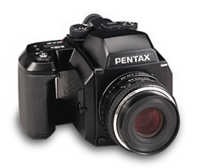
This is an alternate perspective as well as a review of a fabulous camera. I’ll explain. In the Fall of 2001 I put together aPentax 67 IIsystem for rugged location shooting in situations where myRollei 6008system had weakness, such as its dependence on proprietary rechargeable batteries and its sensitivity to wet conditions.
After some initially satisfying andsuccessful field use, and after putting together a kit with one 67 body and 5 lenses, it was clear that it really couldn’t serve as a complete system until I had a second body. This is vital in any camera system. Equipment fails in the field, and because I frequently shoot on hiking trips, when river rafting or otherwise a long way from home, a second body was a must to complete the system. My only concern was that another67 IIbody is a big and bulky thing. It turns out though that there’s a different and unique solution.
Pentax has two medium format camera lines, thePentax 67and thePentax 645. Unique among camera makers, Pentax has designed the systems so that the lenses from the 6X7 camera canalsobe used on the 645 body. They manufacture an adaptor for this that retains autodiaphram and open-aperture metering capability. Put it on a 645 body and you can use all your 67 lenses pretty much as normal. (Contax allows their 645 lenses to be used on the N series 35mm cameras. Pentax has an adaptor that allows medium format to 35mm as well, but in this case autodiaphram is lost.)
 Three Flamingos, Yucatan, 2002
Three Flamingos, Yucatan, 2002
Photographed with a Pentax 645NII and Pentax (67) 300mm f/4 lens on Provia 100F
The original Pentax 645 was introduced in 1984. In late 1997 Pentax upgraded it to the 645N and added autofocus capability along with a line of autofocus lenses. In the Fall of 2001 they upgraded this again to the645N II, and this is the camera that I bought as backup and as second body to myPentax 67 IIsystem.
But after only a bit of use as a second body I realized that this camera had quite a few advantages, and it has increasingly become a stand-alone camera in its own right.
![]() After only a short while using thePentax 645N IIas a second body on thePentax 67iiI found that I was enjoying its use so much that I bought several AF lenses for it. This way it also became a stand-alone system in its own right. The lenses I chose were the35mmf/3.5 AL(IF),75mmf/2.8 and the150mmf/2.8 IF. These three lenses, the body, and an extra film insert, along with filters and film, all fit comfortably into a very smallDomkeshoulder bag � ideal for international travel and airline carryon.
After only a short while using thePentax 645N IIas a second body on thePentax 67iiI found that I was enjoying its use so much that I bought several AF lenses for it. This way it also became a stand-alone system in its own right. The lenses I chose were the35mmf/3.5 AL(IF),75mmf/2.8 and the150mmf/2.8 IF. These three lenses, the body, and an extra film insert, along with filters and film, all fit comfortably into a very smallDomkeshoulder bag � ideal for international travel and airline carryon.
Some Comparisons
If one is going to buy a medium format camera these days, especially 645, then autofocus is pretty much the norm. Currently the three competitors in the field are theMamiya 645AF, theContax 645and thePentax 645NII.
If, as I was, you are looking for a second body for yourPentax 67,thenskip aheadto the next section, because only a Pentax 645 body will be able to take your Pentax 67 lenses. But if you are looking for an autofocus 645 system, and have no compelling reason to chose one over the other, here is a quick competitive feature comparison. Note that I am only doing a basic feature comparison, and that an actual competitive shoot-out between these three marques will have to wait for another day.
Price:
Checking with my favourite on-line dealer,HarrysProShop, I found the following prices for all three cameras (Jan, 2002). Each is complete with 120 film back and normal lens. (Prices have been converted to $U.S.) Note that these are likely some of the lowest prices around. Most retailers sell for quite a bit more, but it varies from country to country.
Contax 645 � $3,320
Mamiya 645AF � $3,005
Pentax 645NII � $2,125
This makes the Pentax 36% less expensive than the Contax and almost 30% less than the Mamiya. This price differential also extends to lenses and most accessories, with Contax being the most expensive in most categories, especially lenses.
Other Features:
When it comes to weight and bulk the Pentax is also the winner. Almost a half kilo lighter than the Mamiya and Contax.
All three cameras have focal plane shutters. The Pentax’s maximum speed is 1/1000 sec while the other two go to 1/4000 sec. This means that they also have faster flash sync speeds as well â�� 1/125sec, while the Pentax is only 1/60th second.
The Contax and the Mamiya have full interchangeable backs while the Pentax takes inserts only. The Contax has an interchangeable prism while the Mamiya and Pentax’s prism are integral with the camera. (The usefulness of waist-level finders on a 645 camera is debatable unless one shoots strictly horizontals). All three cameras feature film-margin data imprinting, and motorized film advance at a rate of 1.5 â�� 2 FPS. Not blindingly fast, but convenient. All three also feature diopter adjustment on their prism eyepieces.
The biggest criticism that can be leveled against the Pentax is that it lacks interchangeable film backs. Frankly, unless ones shooting habits involve constantly switching film types, this isn’t that critical. The Pentax takes inexpensive film inserts at $175 a piece while backs for the Mamiya and Contax are between $450 and $500 each.
It has been said that because it lacks interchangeable backs, in the future the Pentax 645 won’t be able to take a digital back. Nonsense. While it’s unlikely that third parties will modify their digital backs to fit the Pentax’s insert opening, there’s no technical limitation preventing Pentax from providing a digital insert if they so wished. (In fact I believe that the reason for the NII upgrade was primarily to provide the needed electronic shutter release connections for the digital back, which Pentax has indeed now done. Time will tell.)
The three cameras all provide mirror lock up, electric remote release provision, auto bracketing, and a wealth of other contemporary features.
Battery power is provided by 6AA batteries on both the Pentax and Mamiya, and both cameras are reputed to provide excellent battery life. The Contax uses 2CR5 format batteries and unfortunately the Contax has developed a reputation as a battery eater.
Lenses:
Contax usesZeisslenses, while Pentax and Mamiya manufacture their own. As is well known, Contax’s Zeiss lenses are manufactured in Japan under license byKyocera.
While the Zeiss name has a definite cachet, few would argue that Mamiya and Pentax both have excellent reputations with their medium format lenses, and both of these companies have been making such lenses for many decades. Price, features and availability in the focal lengths that you require should be determining factors, not brand name.
Price of course is always an issue, especially with lenses, because most of us buy so many of them 🙂 By way of comparison, Contax’s 210mm f/4 sells atHarrysProShopfor $1,815. The Mamiya 210mm f/4.5 sells for $1,315 and the Pentax 200mm f/4 is $720. Similar price spreads apply across the lines.
Tough to choose isn’t it? Anyhow, back to the Pentax 645 NII.
The Basics
If you’re coming from 35mm there are some things that will be familiar and some you’ll find foreign. You will be initially surprised at how, even though the Pentax produces a transparency 2.5X larger than that from 35mm, the camera itself is only slightly deeper, yet is narrower and not as tall as most pro 35mm SLRs.
Though there’s an LCD on the top plate showing frames used (or left to go), and the ISO film speed that’s set, all other controls are analog. As Martha would say, “This is a good thing.” Handling is exemplary and the viewfinder is bright with a good display, though it only shows just over 90% of the frame exposed. That’s the price paid for small size and low weight. Metering mode is not shown in the viewfinder, which is surprising since it is in thePentax 67.
One of the things that I like is that the exposure and metering system are very logical â�� essentially the same as on myRollei 6008 Integral. With the shutter speed dial and lens both set to (A)utomatic you are in fully auto program mode. Turn the lens ring to an F stop setting and you’re inAperture Priority. Set the shutter speed dial off A with the lens still on A and you’re inShutter Prioritymode. Simple and logical and much easier to use that the modes and LCD screen choices necessary on so many contemporary 35mm SLRs.
While mirror vibration and shutter bounce are a way of life with the Pentax 67, the Pentax 645 (all versions) has anextremelysmooth and gentle mirror action and shutter. In my tests the new model’s mirror lock up turns out to be hardly necessary. First rate performance.
Whereas the Pentax 67II needs to be returned to a service center to have its custom functions programmed, the Pentax 645NII allows you to program all 9 of them yourself using the LCD display. This is the way it should be.

One of the most brilliant features is that virtually all shooting data can be recorded on the edge of the film. I wish all camera did this.
The Advantages as a Second Body for the Pentax 67 lens System
Next, let’s look at the645N IIin its role as a second body for the 67, which is the reason that I bought it in the first place.
There were several advantages to buying a645N IIas a second body instead of another67II.
Motorized film advance:At 2 frames / second this isn’t blindingly fast, but compared to the 67 II ‘s manual wind lever I could see frequent wildlife situations where this would come in handy.
Longer shooting without reloading:Using 220 film the 67 II provides 21 frames, the 645N II 33 frames. When shooting in fast-changing conditions this could make the difference between getting the shot or not.
Quick change inserts:Loading the Pentax 67 II is slow. There’s no getting away from it. The 645NII takes interchangeable film inserts that make reloading at the end of a roll a matter of just a few seconds.
Weight & Bulk:The Pentax 67 II weighs 1,660g with the metering prism. The 645NII weighs 1,280g. For all you non-metric types, that’s nearly a pound lighter. It also takes up a lot less space in a camera bag.
Greater Magnification:When using long lenses there’s the greater magnification. To convert to 35mm terms a 67 lens’ focal length needs to be multiplied by.5X. A 645 image needs a factor of.6X. So a 300mm Pentax 67 lens (which is like a 150mm on a 35mm camera) become the equivalent of a 180mm lens on a 645. Not a big deal, but helpful.(Of course cropping a 67 image to 645 dimensions accomplishes the same thing, but you know what I mean.)
Focus Confirmation:When used with non-autofocus lenses the 645N II provides a focus confirmation light � even with 67 lenses. This can be very helpful in finding critical focus, especially in low light levels.
Using the Sweet Spot:All lenses perform better toward the center than at their edges. By using Pentax 67 lenses on the 645 format one is using the lens’ “sweet spot“, or central area, which exhibits maximum image quality.
The Disadvantages
Greater Magnification:While having greater magnification is helpful with long lenses it’s a hindrance when using wide lenses. My widest, the Pentax 45mm f/4, becomes equivalent to roughly a 28mm instead of a 24mm equivalent lens with the 67 body.
Linkages:Autodiaphram is retained, but matrix metering is lost. This is no great hardship as average metering works just fine, as does spot metering.
Physical Lens Size:Because they need greater coverage for the 6X7cm format these lenses are physically larger than the lenses that are specifically designed for the 645. But, given the versatility and convenience of being able to use the same lenses with two completely different camera systems, this is not a serious issue.
The New 645N
II� Appealing Features
 Lone Crane � Yucatan, 2002
Lone Crane � Yucatan, 2002
Photographed with a Pentax 645NII and Pentax (67) 200mm f/4 lens on Provia 100F � Polarizer
Mirror Lock-Up
The new 645N II came out just weeks before I made my purchase. I had been all set to buy the previous 645N, and doing so would have saved me a bit of money, but there was one feature of the new N II that I definitely wanted â�� mirror lock-up. The previous versions didn’t have this, and according to everything I’ve read didn’t really need it, due to a superior mirror braking system. But it was my plan to use the 645 with my600mm f/4super-telephoto lens, and for this every bit of help in vibration reduction is needed.
The way this is implemented is through a new position on the drive-mode dial. When in this position the first press of the shutter release locks up the mirror and the second press releases the shutter. Mirror lock-up is also available via a custom function when using the self-timer setting. In one mode the self-timer does just that, with a 12 second delay. With the custom function set it first locks up the mirror and then releases the shutter 2 seconds later. Very handy when you don’t have a cable release.
![]() Atest of the MLUwith a surprising result.
Atest of the MLUwith a surprising result.
Film Imprinting
Not new to this model, and not unique to Pentax, the ability of the camera to imprint a variety of shooting data next to each frame is very worthwhile. We learn from our mistakes, and by having such data readily available (as photographers using digital camera well know), one has a permanent record of how the camera was set for every shot.
Autofocus Lenses
Many of the newer Pentax autofocus lenses feature (IF), Internal Focus design. Focusing is achieved without any of the external lens elements rotating or expanding or contracting the lens barrel’s length. This allows Pentax to design their auto/manual focus switch in a novel way. Simply pull back on the wide rubberized focusing ring and the lens becomes manual focus. Slide it forward and it locks into position for autofocus operation, providing a solid grip to the lens, with no danger of one accidentally overriding autofocus. Nicely done.
Polarizer Window
Many Pentax lenses, both for the 645 and the 67 formats, have a small sliding window in their lens shades. Just big enough for a finger to reach in, they allow the photographer to rotate a polarizer without having to remove the lens shade to do so. This may seem like a small matter, but it’s thoughtful design features like this that go a long way to making the ergonomics of the Pentax system appealing.
Not So Appealing Features
The viewfinder lacks metering mode indication. It also doesn’t show the AF mode set. While these are both readily ascertainable by looking at the back of the camera I like to have as much shooting information in the viewfinder as possible. Other than that, this is a very well thought-out and executed camera.
Conclusion
All of this begs the question â�� if the 645N II is such a great camera, with so many advantages, why not just buy a 645N II in the first place instead of a 67 II ? The answer is, image size . Measured as a function of horizontal enlargability a 67 transparency is about25%bigger than 645. In terms of area it is nearly twice as large as one from a 645 camera,1.82Xto be exact. 4235 sq/mm of film area Vs. 2324 sq/mm. That’s one of the reasons I bought the Pentax 67 in the first place â�� the largest possible image size in the most rugged and portable field SLR available.
So, by having two different camera formats, yet needing just one set of lenses between them, I gain the best of both worlds � the superior image quality of the 67 format and the smaller size and technical advantages of 645 when needed. So far it works well for me.
As a stand-alone system the 645NII has a lot going for it. It’s the least expensive autofocus 645 format camera available; is small, rugged, light-weight and has a good selection of reasonably priced lenses. What’s not to like?
Pentax AF500FTZ� andDaylight Balanced Fill Flashfor thePentax 67 and 645
You May Also Enjoy...
Canon Powershot S3 IS Review
Super Zoom DigicamsThat's what they call 'em, and they're an interesting breed. The rapid drop in price of entry level DSRLs (now as low as
